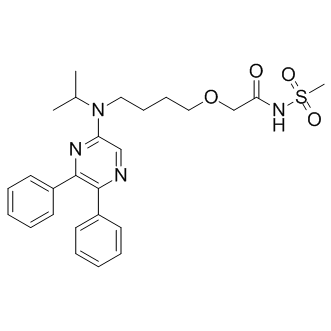| Description: |
Selexipag (NS-304) is an orally available and potent agonist for the Prostacyclin (PGI2) receptor (IP receptor). |
| Target: |
IP Receptor |
| In Vivo: |
The Cmax of MRE-269 after oral administration of NS-304 is 1.1 μg/mL in rats and 9.0 μg/mL in dogs. Selexipag (NS-304) at 1 or 3 mg/kg increases FSBF in anesthetized rats for more than 4 h after intraduodenal administration in a dose-dependent manner. In particular, Selexipag (NS-304) at 3 mg/kg causes a sustained increase in FSBF and exhibits a maximal increase of 93% in FSBF 1 h after administration[1]. |
| In Vitro: |
Selexipag (NS-304) is an orally available and long-acting IP receptor agonist prodrug, and its active form, MRE-269, is highly selective for the IP receptor. Selexipag (NS-304) inhibits the binding of [3H]Iloprost to the human and rat IP receptors in a concentration-dependent manner. The Ki is 260 nM for the human IP receptor and 2100 nM for the rat IP receptor. The intracellular cAMP levels in hIP-CHO cells are increased in a concentration-dependent manner by treatment with Selexipag (NS-304) with EC50 of 177nM. Selexipag (NS-304) also inhibits platelet aggregation in humans and monkeys with IC50 values of 5.5 and 3.4 μM, respectively, but it shows no inhibition in dogs (IC50 of >100 μM)[1]. |
| Cell Assay: |
CHO cells expressing the human IP receptor (hIP-CHO cells) are seeded at 1×105 cells/well in a 24-well plate and cultured for 48 h. The cells are washed with Dulbecco's phosphate-buffered saline without divalent cations, preincubated in the medium for 1 h at 37°C, and then incubated for 15 min at 37°C with medium containing each drug in the presence of 500 μM 3-isobutyl-1-methylxanthine. The medium is removed, and perchloric acid solution is added to terminate the reaction. Intracellular cAMP levels are measured by enzymelinked immunosorbent assay[1]. |
| Animal Administration: |
Mice[1] Male Sprague-Dawley rats, cynomolgus monkeys, and male beagle dogs are used. Selexipag (NS-304) is orally administered to rats at 10 mg/kg and to dogs at 3 mg/kg, and blood samples are collected at various times and centrifuged to obtain plasma. The plasma concentrations of Selexipag (NS-304) and MRE-269 after oral administration of Selexipag (NS-304) to each animal are determined by high performance liquid chromatography coupled to mass spectrometry (LC/MS), and their pharmacokinetic parameters are calculated.Rats are orally administered Selexipag (NS-304) at 3 mg/kg twice daily for 1, 2, 3, or 4 weeks as a pretreatment. On the day after the final administration in the pretreatment, rats are anesthetized with urethane, and the FSBF is measured with a laser Doppler flowmeter after intraduodenal administration of Selexipag (NS-304) at 3 mg/kg[1]. |
| References: |
[1]. Kuwano K, et al. 2-[4-[(5,6-diphenylpyrazin-2-yl)(isopropyl)amino]butoxy]-N-(methylsulfonyl)acetamide (NS-304), an orally available and long-acting prostacyclin receptor agonist prodrug. J Pharmacol Exp Ther. 2007 Sep;322(3):1181-8.
[2]. Mous DS, et al. Treatment of rat congenital diaphragmatic hernia with sildenafil and NS-304, selexipag's active compound, at the pseudoglandular stage improves lung vasculature. Am J Physiol Lung Cell Mol Physiol. 2018 May 10. |






















